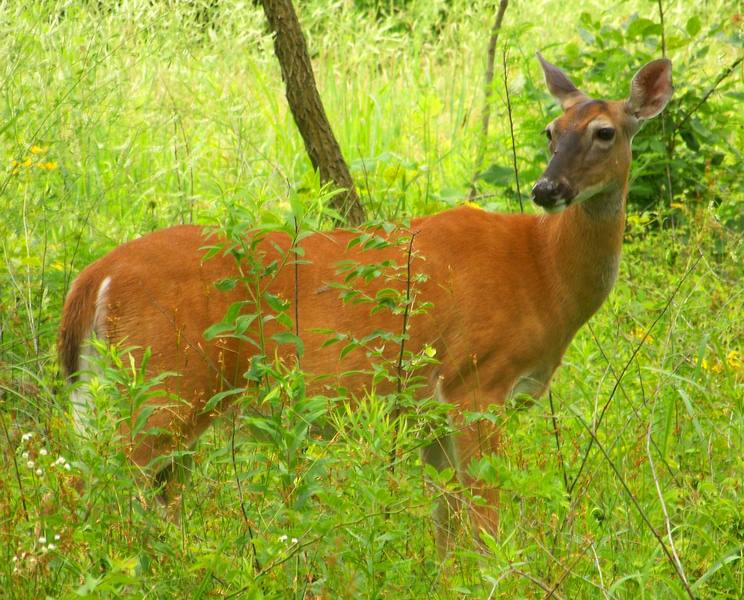Many towns in the United States have noticed a large increase in deer populations. The reasons are many, but the most obvious island development in heretofore deer terrain. The article is about natural deer deterrent gardening.
Deer are a strict vegetarian. The most sage advice in co-existing with the deer in town or in the country is to plant items the deer do not like. There are at least 600 plants that deer either find offensive or simply do not like. Interestingly sage is one plant that deer do not like. Other plants include Peony, Poppy, Mock Orange, and Morning Glory to name a few.

There are numerous products on the market that promise to deter deer from eating up your ornamental plants and vegetable gardens. There are some items in your cupboard and gardening shed that can do approximately the same thing as the store variety.
First off keep in mind that deer will literally eat anything if they are hungry enough. The main thing deer do not like is the smell of animal or human by-products. Specifically, blood meal is abhorred ant to deer. The only problem here is that blood meal has a raunchy smell that most humans do not like either. If you enjoy evenings in the garden, the aroma of blood meal emanating from the garden is not a welcome smell.
Other items suggested by various self-help websites include using human hair, soap, creosote, rotten eggs, and garlic.
The problems with all of these home products and commercial products are that while they may deter the deer they also deter human beings. If you like working in the garden the smell of some of these items is obnoxious.
As an experiment, I tried a few tricks that are not mentioned on the various websites in the hopes of finding something the deer might find disagreeable and I would still be able to spend time in the garden.
Must Read:
- Diagnosing Plant Problems, The Most Common Plant Diseases and How to Cure Them
- Choosing Homemade Gardening Tonics for the Growth of your Garden
- Using Grey Water for Irrigation in the Organic Garden
- Sustainable Gardening: What to Plant, and Where to Plant It
- Early Spring Gardens, Get a Head Start on the Season
- How to Keep Your Houseplants Alive and Healthy
- Gardening Composting: Why and What?
- Is a Deer Proof Garden Possible?
Red Devil hot sauce is readily available in most stores and discount stores. I have purchased a six fluid ounce size for 39 cents. Louisiana Hot Sauce is available at WalMart for around 35 cents. Either one will do, but the Red Devil has more cayenne than the Louisiana variety.
The application is simple. All you do is sparingly sprinkle the leaves. Do not apply the hot sauce to the flowering buds. It dries quickly and there is no lingering odor from the application. Thus far in my experiment, the deer that frequently ate the leaves and buds are not doing so now.
They smell the plants and move on. The deer has an acute sense of smell. If it doesn’t smell right, they don’t try it. The mixture has not affected the plant’s growth either.
The other unique feature of deer is their sense of hearing. While many deer have become accustomed to human beings because of their change in habitat, they do not like sharp or unexplained clanging sounds. It is a feature intrinsic to the deer and a survival mechanism. If the deer hears sharp, or even clanking sounds they usually will speedily make an exit. I moved a chime and bell ornament near the plant area I was trying to protect.
The deer came up and while he nearly took a bite the sound of the chimes frightened him and he took off as fast as his legs would carry him. For larger areas, I have heard about using tin pie plates affixed to one another and clanking objects within the plates. All you need to do is hang them from ornamental trees and shrubs.
In the past several years my neighbor purchased a small bolt of netting. It does not come in small pieces. The netting is a synthetic product black in color and has the look and feel of fishnet. She gave me a small rectangle to try out and it does work beautifully.
The deer simply do not like the hassle of trying to get through the netting. The deer pretty much leave the netted plants alone. The only negative to this method is that your garden is not as colorful. In fact, it looks like a day at the senior center or a school cafeteria kitchen with all of the hair nets.
In conclusion, living with the deer population can be a real chore, but picking the right plants, employing some simple gardening practices can make the experience less troublesome. After all, isn’t that why we all love the wide open spaces with all of God’s creatures coexisting.